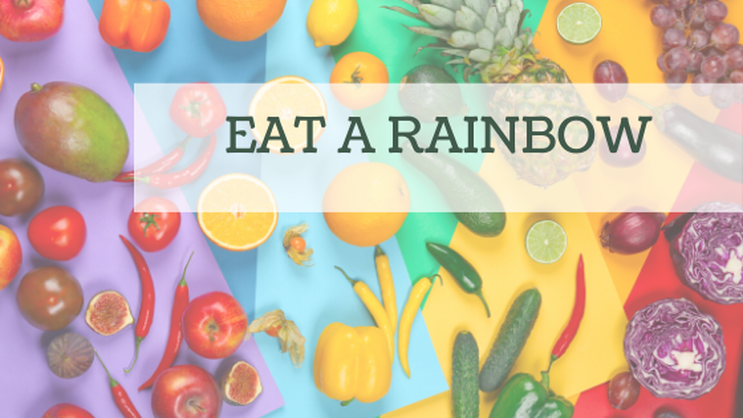|
We should all aim to eat a rainbow every day (and no, I’m not talking about skittles and m&ms!). A variety of colourful fruit and vegetables will bring us a rainbow of colour and nutrients. To optimise health and help prevent chronic disease, we need to eat 5 serves of veggies and 2 fruits every day!
Each fruit and vegetable’s vibrant colour, taste and aroma is caused by specific phytochemicals produced by the plant to help protect the plant from things such as insect attack or the sun's UV radiation. Although phytonutrients are not essential for us to survive (un-like vitamins, minerals, protein etc), they do provide significant benefits for humans who eat these plant foods. All colourful fruits and vegetables have these nutrient powerhouses, as do legumes, nuts, tea, wholegrains and many spices. Each colour brings the food it’s own distinctive variety of vitamins, minerals, antioxidants and phytonutrients our body needs to thrive. Diets full of a variety of phytonutrient-rich plant foods have shown to be effective at reducing the risk of heart disease, diabetes, and certain types of cancers and promoting longevity. There are more than 25,000 phytonutrients (and i'm sure many which are yet to be found), of which some groups are of particular interest. It is easy to fall into the habit of buying, cooking and eating the same limited variety of fruits and vegetable that you and your family like, but eating enough plant foods is important, and a wide variety is the key as most people fall short in most colour categories of phytonutrients. RED fruits and vegetables contain phytochemicals, including lycopene, anthocyanins and ellagic acid which have been studied and linked with reducing the risk of diabetes, heart disease and stroke, age-related vision impairment, preventing certain cancers. Lycopene in particular, found in highest concentrations in watermelon and cooked tomatoes, is known to help prevent prostate cancer. Ellagic acid, in raspberries, strawberries, blackberries, cranberries, grapes, pomegranates and even walnuts, is also a potent antioxidant associated with anti-cancer activity, may also help to reduce blood pressure and build-up of plaque in the arteries and slow glucose absorption in the gut.
ORANGE AND YELLOW foods are full of carotenoids such as beta-caotene, beta-cryptoxanthin and lutein which are also strong antioxidant and anti-inflammatory phytonutrients. These foods have been associated with improving immune function, preventing various cancers and heart disease, promoting healthy joints, skin and eye health and vision (yes, it is true that carrots can help with your eye-sight!).
GREEN fruits and vegetables are rich in phytonutrients and chlorophyll which is loaded with antioxidants that promote well-being. Green fruits and vegetables are one of healthiest foods we can eat and are rich in lutein, zeaxanthin, isoflavones and many other phytonutrients. Green plants have been linked with reducing risk of several cancers, blood vessel damage, heart disease, boosting the immune system and energy levels. The consumption of flavonoids, of which some are in green plant foods, is significantly associated with longevity.
BLUE AND PURPLE fruits and vegetables are rich in the phytonutrients anthocyanins and resveratrol, and have been studied extensively for their anti-cancer, anti-inflammatory and anti-aging properties. These work to repair damage from oxidative stress and inflammation and reduce the risk of cancer, stroke and heart disease. Reversatrol may also protect brain function and slow cognitive decline and is being studied as a possible treatment for type-2 diabetes.. Large concentrations of reversatrol are found in red wine which may explain the health benefits associated with red wine consumption. The skin of grapes are also a great source as well as grape juice, blueberries and cranberries and even peanuts and cocoa.
I need to clarify here that these phytonutrients in their whole-food form (ie eating them in a real food) have shown to be beneficial, however taking these in supplement form has not shown the same benefit and isn’t recommended as they may increase the risk of some health complications. The only way to increase the intake of phytonutrients is to eat more plant foods and include a varied array of colours to reap all of their benefits! Try cooking with a wider range of vegetables, add more into the foods you regularly eat and try new recipes and develop an appreciation for new foods. Of course, eating a rainbow is harder for kids who are still learning to like veggies! Always expose children to as many different nutritious foods as possible. Don’t give up if they refuse the new vegetable the first, second, third or even fourth time theyre offered it. It can take around 20 times of being exposed to a new food before children learn to accept it. They may start by flicking it off the plate, then being okay with it there, then poking or picking it up, then licking it or tasting and spitting it out. Eventually, with repeated exposure and no pressure to eat it, they will learn to accept it – especially if they see other family members/parents eating it! Other types of exposure to vegetables will also help kids be more curious about them, reduce anxiety around eating them and make them more likely to try them, accept and even like them! Reading about them, looking at and talking about them in the supermarket, helping to grow, prepare and cook them, and especially seeing them on the plate every day helps. Even colouring them in may help, so download the ‘Eat a Vegetable Rainbow’ colouring page here and lettuce see your little one’s best colouring! There will be winners announced in March 2020, but feel free to colour the page anytime! Alysha
0 Comments
Leave a Reply. |
|
I acknowledge the Wurundjeri people of the Kulin Nation as the traditional custodians of the land on which I live and work . I pay my respects to Elders past, present, and emerging..

